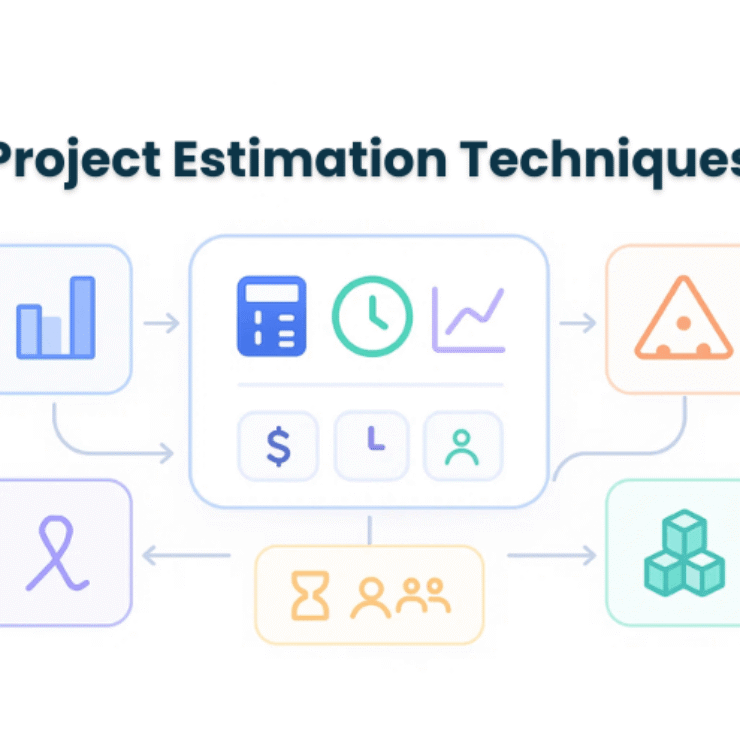Introduction
Ever wondered how successful projects seamlessly navigate from start to finish?
The answer lies in the project life cycle, a structured approach to managing the complexities of project execution. Project managers need to understand the project life cycle because it provides a methodical overview of a project’s journey from start to finish. To lay the groundwork for a more in-depth discussion of each stage’s significance and application for efficient project management, we will examine the project life cycle’s importance and give a quick rundown of its main phases in this introduction.
Why Are Project Phases Important?
Project phases are essential to project management because they offer clarity, organization, and structure for the duration of the project. They provide teams and project managers with a road map by segmenting the work into smaller, more manageable work packages, each with clear deliverables and goals. This division of the project into phases helps in better planning, resource allocation, and risk management.
Project phases also help with effective management and supervision, allowing teams to keep an eye on things, identify potential issues early, and take the appropriate corrective action. By establishing distinct benchmarks and checkpoints for evaluation and input, the phased approach also promotes stakeholder engagement and communication. All things considered, incorporating project phases into enterprises, jobs, or projects guarantees more efficient operation, enhanced teamwork, and higher project success rates.
Understanding the Project Life Cycle
- Initiation Phase:
- Define project goals and objectives.
- Identify key stakeholders.
- Planning Phase:
- Create detailed project plans.
- Define project scope.
- Establish timelines and resources.
- Execution Phase:
- Implement the project plan.
- Perform tasks and manage resources.
- Monitoring and Controlling Phase:
- Track project progress.
- Assess performance.
- Make necessary adjustments to ensure success.
- Closing Phase:
- Finalize deliverables.
- Obtain approvals.
- Conduct post-project reviews.
Also Read:
Project Management Framework – Understanding the Types, Elements, and Best Practices
Top Reasons Your Organization Needs Project Management Software
How to Track Project Progress & Deliver Projects on Time?
10 Tips to Project Managers for Effective & Successful Project Management
Project management effectiveness requires an understanding of the project life cycle. It provides a structured framework for organizing and managing project activities, facilitating better decision-making, and ensuring successful project outcomes.
Initiation Phase
The initiation phase marks the beginning of a project journey and is crucial for laying the groundwork for success. Its primary objectives include defining the project’s scope, objectives, and deliverables, as well as identifying key stakeholders and understanding their needs and expectations.
Example:
When Tanner, a project manager at a tech startup, was assigned a new software development project, he spent the initiation phase thoroughly defining the project’s scope and objectives.
Tanner identified key stakeholders, including the development team, marketing department, and potential users, ensuring their needs and expectations were clearly understood. By meticulously planning and assessing potential risks, Tanner established a solid foundation for the project, setting the stage for its successful execution.
This detailed approach during the initiation phase helped Tanner and his team anticipate challenges and align the project with the company’s strategic goals.
This phase requires extensive planning since it establishes a clear direction, identifies potential risks, and ensures alignment with organizational objectives—all of which are critical to the project’s success. By investing time and effort into comprehensive planning during the initiation phase, project managers can mitigate risks, anticipate challenges, and lay a solid foundation for the successful execution of the project.
Planning Phase
The planning phase is a critical stage in the project life cycle, serving as the blueprint for the project’s execution. Its significance lies in its ability to provide structure, direction, and clarity to the project, setting the stage for successful implementation. During this phase, various activities are carried out, including creating comprehensive project plans, defining project scope, establishing realistic timelines, and allocating resources effectively.
Example:
Michelle, a senior project manager at a construction firm, was tasked with overseeing the development of a new office building.
During the planning phase, Michelle meticulously created detailed project plans, clearly defined the scope of work, and established realistic timelines. She also effectively allocated resources, ensuring that each team had the necessary tools and personnel. Michelle’s comprehensive planning included identifying potential challenges, such as supply chain delays and regulatory approvals, and developing contingency plans.
By anticipating resource needs and setting clear objectives and milestones, Michelle increased the likelihood of the project’s success, providing a clear and organized path forward for her team.
Comprehensive planning is essential as it ensures that all aspects of the project are carefully considered and accounted for, minimizing risks and uncertainties. By thoroughly planning during this phase, project managers can identify potential challenges, anticipate resource needs, and establish clear objectives and milestones, ultimately increasing the likelihood of project success.
Execution Phase
The execution phase represents the stage where the rubber meets the road in project implementation, where plans transition into action. Its role is central to turning project objectives into tangible outcomes, as teams work diligently to carry out tasks, manage resources, and maintain open lines of communication.
Example:
Leading a major software development project, Marvin’s team moves into the execution phase, translating detailed plans into actionable tasks like coding and testing.
By tracking resources and holding daily stand-up meetings, Marvin ensures optimal utilization and effective coordination. Regular updates keep stakeholders informed and engaged, helping the project stay on course toward its goals.
Activities during this phase encompass task execution, where team members work towards completing assigned activities, resource management to ensure optimal utilization of available resources, and consistent communication to keep all stakeholders informed and engaged. In order to promote alignment, enable prompt decision-making, and guarantee that the project stays on a course toward its intended goals, effective coordination and communication are essential during the execution phase.
Monitoring and Controlling Phase
The monitoring and controlling phase is a critical stage in project management, dedicated to overseeing project progress and ensuring alignment with established objectives. Its primary objectives include tracking project performance, identifying deviations from the plan, and taking corrective actions as necessary to keep the project on course.
Example:
In Kirby’s construction project, the monitoring and controlling phase involves regular site inspections, progress reviews, and budget assessments. By analyzing variances and addressing issues promptly, Kirby ensures that the project stays within budget and meets quality standards.
Continuous monitoring allows him to adjust schedules and resource allocation as needed, ensuring project success within specified constraints.
During this phase, a range of activities is carried out to monitor project progress, assess performance, and address any issues that may arise. These activities may include regular status updates, performance reviews, milestone tracking, and variance analysis. Continuous monitoring and controlling are essential to ensure that project objectives are met within constraints such as time, budget, and quality.
Closing Phase
The closing phase of a project marks the culmination of all efforts and signifies its successful completion. This phase holds immense significance as it ensures that all project activities are wrapped up efficiently and that stakeholders’ expectations are met. Activities during the closing phase include finalizing deliverables, obtaining approvals from stakeholders, and conducting post-project reviews to evaluate performance and identify lessons learned.
Example:
In Pete’s software development project, the closing phase involves finalizing the software release, obtaining approvals from stakeholders, and conducting a post-project review. By documenting lessons learned and sharing insights with the team, Pete ensures continuous improvement in future projects. Additionally, by delivering on commitments and formally closing out the project, Pete fosters stakeholder satisfaction and builds trust for future collaborations
Proper project closure is important as it allows for knowledge transfer, capturing valuable insights and best practices for future projects. Exhibiting accountability and keeping promises, also promotes stakeholder satisfaction. By executing a thorough closing phase, project managers not only formalize project completion but also lay the groundwork for continuous improvement and success in future endeavors.
Wrap Up
The importance of the project life cycle and its main stages—initiation, planning, execution, monitoring and controlling, and closing—were discussed in this article. Throughout the course of the project, each phase is essential in maintaining structure, order, and clarity, which improves planning, resource allocation, and risk management.
Understanding the project life cycle is vital for effective project management. It equips project managers with a systematic approach to navigating complexities, making informed decisions, and achieving successful outcomes.
By embracing the principles of the project life cycle, project managers can guide their projects from conception to completion with confidence, ensuring that each stage is executed smoothly and efficiently. This structured approach not only enhances collaboration and communication but also increases the likelihood of project success.
FAQs
How do you determine the success criteria for a project?
Success criteria for a project are typically determined during the planning phase and should align with the project goals and stakeholder expectations. These criteria can include specific deliverables, completion times, budget constraints, and quality standards.
What is the role of a project manager in each phase of the project life cycle?
A project manager oversees all phases of the project life cycle, ensuring that each phase is completed on time and within budget. They facilitate communication, coordinate tasks, manage resources, monitor progress, and handle any issues that arise.
How do project life cycles differ between industries?
While the basic phases of the project life cycle remain the same, the specific activities, methodologies, and tools used can vary significantly between industries. For example, software development projects may use agile methodologies, while construction projects might follow more traditional project management frameworks.
Can the project life cycle be adapted for small projects?
Yes, the project life cycle can be scaled and adapted for small projects. The same phases apply, but the processes can be simplified, and fewer resources may be required. The key is to maintain a structured approach to ensure project success.
How do you handle changes in project scope?
Handling changes in project scope involves a process known as scope management. This includes identifying potential changes, evaluating their impact on the project, obtaining stakeholder approval, and updating project plans and documentation accordingly.
What is the difference between the project life cycle and the product life cycle?
The project life cycle focuses on the phases a project goes through from initiation to closure. In contrast, the product life cycle refers to the stages a product goes through from development and market introduction to growth, maturity, and eventual decline.
About the Author - About Nicholas Mendez (Nick Mendez):

Nicholas Mendez (Nick Mendez) is a 26-year-old tech professional with 5+ years of cyber security, and technology project management experience. He earned his PMP certification on April 30, 2023, marking a significant milestone in his career. Since then, he’s written many guest posts and blog posts where readers have received a great amount of value and knowledge to prepare for their PMP exam.
Check out his FREE exclusive top-notch PMP study resources at nickmendez.co and get ready to take your career to the next level!



